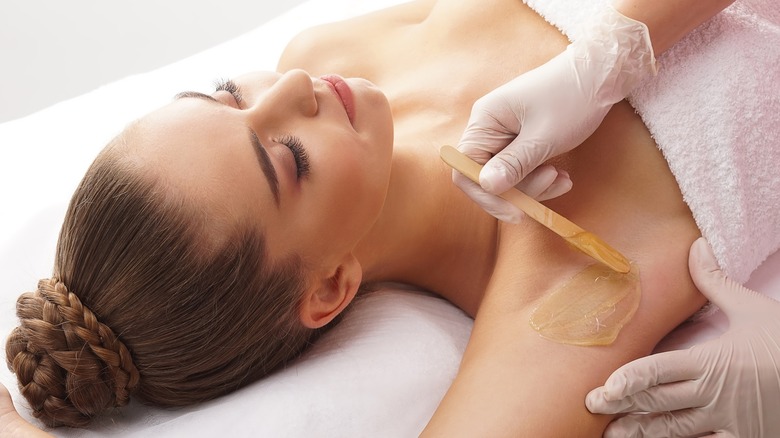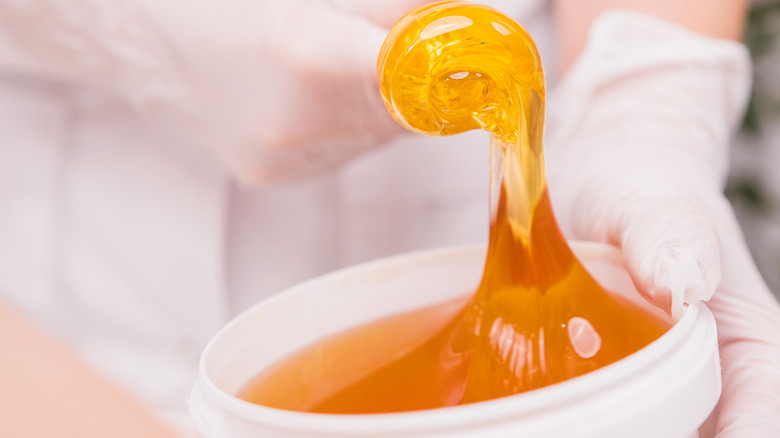Should You Try Sugaring To Remove Hair?
For ages, having minimal body hair is considered sexually attractive for women. In modern-day society, having hair-free or nearly hair-free armpits and legs has become a societal norm, if not a social standard of beauty and body image. For this reason, shaving or waxing becomes a rite of passage for most girls as they hit puberty. Heather Widdows, professor of global ethics at the UK's University of Birmingham tells CNN: "Today, most women feel like they have to shave. Like they have no other option. There's something deeply fraught about that — though perceptions are slowly changing." While hair removal is mostly for aesthetic purposes, it also helps to maintain body hygiene.
"Armpit hair is a collecting site to help bacteria grow," explains dermatologist Dr. Shani Francis vialas Health. Since armpit hair traps sweat, they give off an unpleasant odor that might be perceived as a sign of poor hygiene and might discourage sexual attraction. Today, there are numerous alternatives to shaving and waxing for the rapid and lasting removal of unwanted hair, including laser therapy, threading, electrolysis, and sugaring. Among these, sugaring is arguably the most natural and affordable option. Don't discount the impact of this method because sugar is a kitchen ingredient. Actually, sugaring dates back to the ancient Egyptians, who used sugar to lift hair from the roots and minimize hair regrowth. However, the simplicity of this technique raises questions about its efficacy against other cutting-edge hair removal techniques. Here's what experts have to say.
What is sugaring?
Fundamentally, sugaring is a practice where you use a cooled, sticky paste made of lemon, sugar, and water on clean and dry skin and thereafter remove them in a manner that's similar to waxing. You can use sugar to remove unwanted hair on any part of your body, from your upper lip to your bikini line. Esthetician Dr. Alexandra Accardo tells Byrdie: "It's applied to any area that has unwanted hair and is then removed in the direction of the hair growth." Since sugaring doesn't stick to the top layer of the skin, it doesn't damage live skin cells and thus spares you unnecessary skin irritation coupled with a loss of natural body oils. Instead, it removes hair from the root.
While sugaring sounds similar to waxing, the main distinction is the direction in which the hair is pulled, says dermatologist Dr. Amy Kassouf as per Cleveland Clinic. Waxing involves applying wax in the same manner as hair growth and removing it in the opposite direction. On the other hand, with sugaring, you'll need to apply the blend in the opposite way of your hair growth and remove it in the same lining of your hair growth. But before sugaring your body, make sure your hair is at least a quarter inch long and lightly exfoliate your skin to buff away dead skin cells. Getting rid of dead skin cells before getting sugared helps to soften the skin, prevent hair breakage, and deliver the smoothest results possible.
Benefits of sugaring
Fortunately, since sugaring doesn't adhere to the skin while removing hair, it's considered less painful than waxing. However, everyone's pain threshold differs and some might still experience skin irritation after sugaring. In addition to that, sugaring is safe for those with sensitive skin because it's formulated with organic ingredients and thus gentler on the skin. Also, sugaring helps to minimize ingrown hair and protect your hair follicles from potential bacterial infection and scarring, Sugaring Cane points out. However, the results yielded by sugaring can be quite limited.
Dermatologist, Sapna Palep, explains to Allure: "Hair is removed temporarily after just one session and typically, results last three to five weeks." However, sugaring may reduce hair regrowth over time, so you'll have less hair to sugar the next time. While you can sugar unwanted hair at home, it's best to let a dermatologist do the sugaring for you, to minimize errors and side effects. Besides, your dermatologist knows best which hair removal technique works for your skin type. For instance, if your body hair is thicker, laser or waxing might offer more desirable results in the long run. On the other hand, wrapping up and sugaring might be comfier than waxing or shaving and much cheaper than laser therapy, but you'll need ongoing sessions to get the unwanted hair removed. If you have patience and a low pain threshold, sugaring might be the best method for you.


